Idiopathic Clubfoot (Congenital Talipes Equino Varus) is one of the oldest and commonest musculoskeletal anomalies known to mankind. Much controversy still exists regarding clubfoot with respect to etiology, pathologic anatomy, classification, treatment and evaluation criteria.
Different criteria to assess the severity of deformity, its progression and to evaluate the results of treatment have been advocated [1–3]. Numerous radiographic angles have also been used [4,5].
In a recently published study, Derszi et al., used the Dimeglio method with good efficacy for management and evaluation of congenital clubfoot in children after walking age [7].
Analytical Radiographic techniques to assess the deformity and to evaluate the treatment of clubfoot are very popular [4] but are controversial due to standardization difficulties and their reproducibility [4,8]. There is no single large study done to compare the FBM method or podography with analytical radiography with respect to assessment of clubfoot deformity and its management.
Through the present study, we attempt to comparatively evaluate the roles of podography and radiography in the management of idiopathic clubfoot in order to propose a simpler, more objective, easily reproducible and cost effective assessment method.
Materials and Methods
We conducted a prospective study at the Pediatric Orthopedic Clinic of Subharti Hospital affiliated to Subharti Medical College, Meerut, India over a 5 year period from September 2004 to October 2009. Processing of the cases was approved by the Institutional Ethical Committee of Subharti Medical College, Meerut. Written informed consent was duly obtained from parents of each patient before the study.
Our study included follow up of 60 feet in 48 patients of idiopathic clubfoot managed by Ponseti technique. All the patients were put to thorough clinical, podographic and radiographic examination of both feet. The patients were assessed by standard clubfoot radiography and podography in terms of FBM angle before starting treatment, after 6 weeks and at six monthly intervals with a maximum follow up period of 5 years.
The feet were categorized into clinical grading of deformity by Harrold and Walker grading as described by Jain et al., [2].
Grade I: The foot could be passively held at or beyond the neutral position.
Grade II: The foot could not be brought to neutral and the fixed equinus or varus was < 20 degrees.
Grade III: The fixed deformity was > 20 degrees of equinus and varus.
Pre-treatment and post-treatment functional evaluation was done by Modified Magone’s scoring system [9]. All patients were treated with Ponseti Technique [10].
Technique of Podography
After keeping the foot plantigrade, the foot tracing was taken on paper sheet. Simultaneously the levels of both lateral and medial malleolus were marked on each footprint. The long axis of foot was drawn taking the second toe and most convex part of the heel as two reference points, this was intersected by a line joining the two malleoli and the anteromedial angle of the intersection was taken as the FBM angle [Table/Fig-1]. By measuring the FBM angle the foot deformity was quantified.
Foot print or podography technique and drawing of Foot Bimalleolar Angle. (FBM);
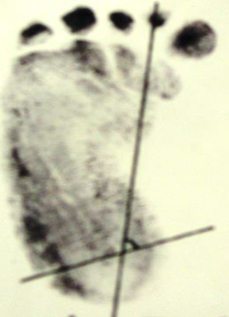
Each patient was subjected to antero-posterior and stress dorsiflexion lateral view of feet and talocalcaneal, talo-first metatarsal angle and tibio-talar angles were measured. Anteroposterior view was taken by placing the foot flat on X-ray plate and tilting the tube 30 degrees from the vertical plane. Stress dorsiflexion lateral view was taken by forceful dorsiflexion at midfoot level [Table/Fig-2].
Diagrammatic representation of radiological angles in antero-posterior(AP) and stress dorsi-flexion lateral view.
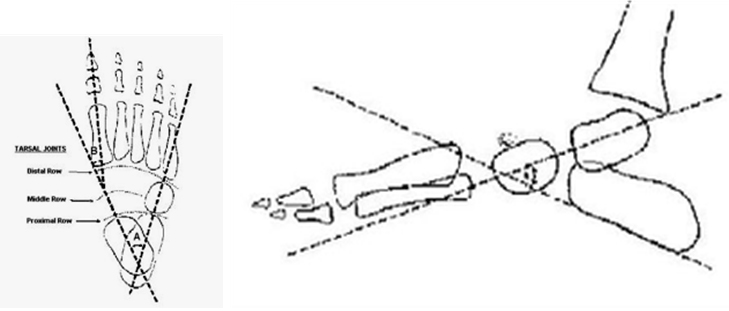
Magone’s Scoring System is a comprehensive rating system for functional results after corrective procedures, with 100 points indicating a normal foot. The various components of clubfoot deformity, ankle motion and patient subjection in reference to pain and function are emphasized in this scoring system. We have used the Modified Magone’s Scoring System [9] which includes parental satisfaction. The results are classified as:
Excellent: 90-100 points
Good : 80-89 points
Fair: 70- 79 points
Poor: < 70 points.
After clinical grading of deformity, serial manipulations and casting by standard Ponseti’s method [10] was done. Percutaneous tendo achilles tenotomy was done in all the patients under short general anaesthesia in operation theatre. After the tenotomy another corrective cast was given for a period of 3 weeks. Complete blood count as well as bleeding and clotting time was done prior to tenotomy.
After registration, parents were counseled on the follow up programme. The treatment protocol decided was discussed in detail and the family particularly mother were reasoned to achieve their cooperation and gain their confidence in the treatment.
Selection criteria for Ponseti treatment:
All newborns with clubfoot deformity.
All new as well as neglected patients till the age of 7 years.
Patients deferred for surgery due to medical or anaesthetic reasons.
After correction by Ponseti’s technique, Steinbeck’s splints were given for 3 months following correction. A clubfoot was defined as corrected if there was no varus at heel and or equinus at ankle and the foot was pliable and plantigrade with painless subtalar motion. These patients were assessed regularly clinically, functionally. podographically and radiologically at the aforementioned intervals.
FBM angle by podogram was taken as an important parameter and was correlated with clinical correction and functional evaluation. The radiographic evaluation was analysed and similarly correlated with clinical correction and functional outcome. These podographic and radiographic correlations were critically compared and analysed by standard scoring system recommended by Magone [9].
Results
In the present study of 60 feet (48 patients), 60% were male patients and out of these 55.5% were below one year age group. Total 81% patients were below the age of 2 years and 9% patients were in the age group of 2-5 years and 10% patients were in the age group of 5-7 years. Unilateral involvement was seen in 50% patients while deformity was bilateral in 50% cases patients. Interestingly incidence of right and left foot was equal in unilateral cases and all patients above 5 years age group were males. A total of 10 patients were with right foot involvement and 10 were involving the left foot. Varus deformity > 20 degrees was seen only in 12% cases and 80% patients had varus deformity ranging from 6 to 20 degrees. A total of 42 feet (70%) had equinus deformity between 21 to 50 degrees. Very severe equinus i.e., beyond 60 degrees was present in only 5 feet. In less than one-third of cases (30.66%) severe adduction deformity of more than 20 degrees, represented as medial crease was clinically present. A total of 42 feet (70%) had adduction deformity less than 20 degrees. Cavus deformity was present in nearly half the cases.
Analysing all the data after treatment about 92% patients had an FBM angle of greater than 70 degrees (good correction), out of which 18 % showed complete correction. [Tables/Fig-3]. These results correlated well with post treatment Magone’s score of > 80(good to excellent) in nearly 85% cases [Table/Fig-4]. Radiologically talocalcaneal angles in both the views had improvement in only 60% of cases. Other radiographic parameters did not show any significant correlation. Representative case example for podograpy [Table/Fig-5 and 6] and radiography [Table/Fig-7,8,9 and 10] are illustrated.
Important Podographic and radiographic measurements in 60 feet.
| Podography | Radiological Data |
|---|
| N=60 | Foot Bimalleolar angle | Anteroposterior view | Stress dorsiflexion lateral view |
|---|
| Angles(Degree) | <65 | 65-69 | 70-74 | >75 | TC(15-24) | TC(25-30) | TMT1(1-9) | TMT1(10-30) | TC(15-24) | TC(25-30) | TT(50-69) | TT(70-80) |
| Pre-treatment (N) | 05 | 40 | 15 | 00 | 10 | 50 | 20 | 40 | 36 | 24 | 42 | 18 |
| Pre-treatment(percentage) | 8 | 66 | 26 | 0 | 16 | 84 | 30 | 70 | 60 | 40 | 70 | 30 |
| Post-treatment | 00 | 05 | 45 | 10 | 24 | 36 | 60 | 00 | 24 | 36 | 0 | 60 |
| Post-treatment(percentage) | 0 | 8 | 75 | 17 | 40 | 60 | 100 | 0 | 40 | 60 | 0 | 100 |
(TC: Talo Calcaneal angle, TMT: Talo first metatarsal angle, TT: Tibio-Talar angle)
Magone’s Score : Pre and Post treatment Score.
| Pre Treatment | Post Treatment |
|---|
| Score | N =Number | Percentage | N= Number | Percentage |
|---|
| Excellent(90-100) | 00 | 0 | 24 | 40 |
| Good (80-89) | 00 | 0 | 27 | 45 |
| Fair (70-79) | 09 | 15 | 03 | 05 |
| Poor (<70) | 51 | 85 | 06 | 10 |
Pre Ponseti treatment Foot Bimalleolar angle (FBM) of 65 degrees;
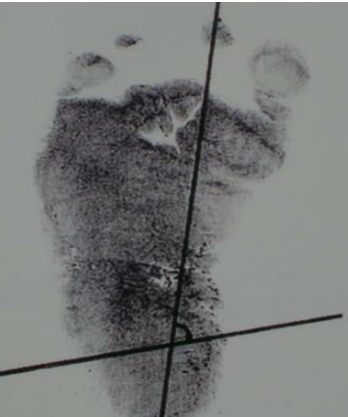
Post Ponseti treatment Foot Bimalleolar angle (FBM) of 80 degrees;
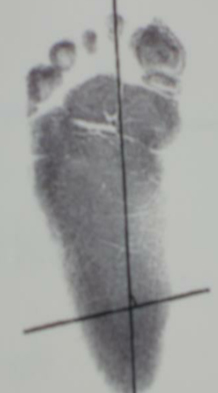
Pre Ponseti treatment Talo Calcaneal angle of 35 degrees in antero-posterior radiographic view.
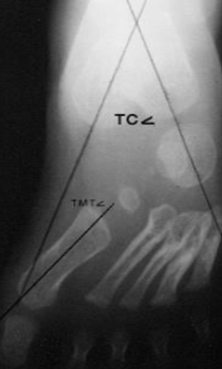
Pre Ponseti treatment Talocalcaneal angle of 18 degrees in stress dorsiflexion lateral radiographic view;
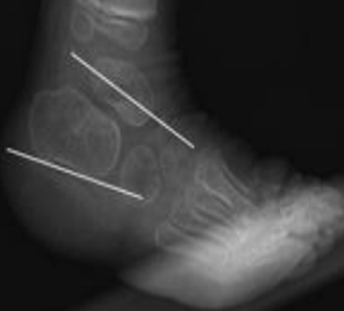
Post Ponseti treatment Talocalcaneal angle of 33 degrees in AP view;
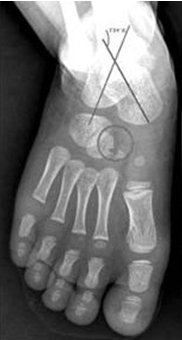
Post Ponseti treatment Talo calcaneal angle of 28 degrees in stress dorsiflexion Lateral view.
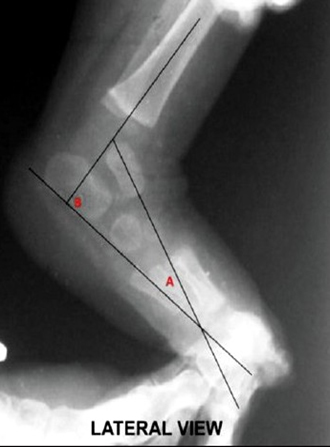
Statistical Analysis
The Karl Pearson co-efficient of correlation between the post treatment score and the podogram came out to be strongly positive (0.6920). The relationship between improvement in TCA angles and podograms towards the normality and improvement in scores are shown on line diagrams [Table/Fig-11,12].
Line diagram showing good podographic correlation with functional foot correction before and after Ponseti treatment.
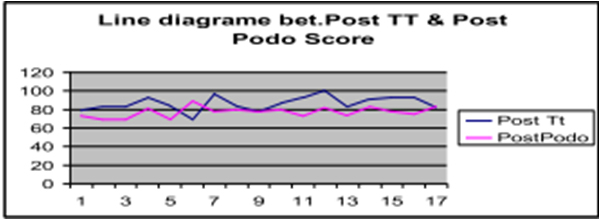
Line diagram showing insignificant radiological correlation with foot correction before and after Ponseti treatment.
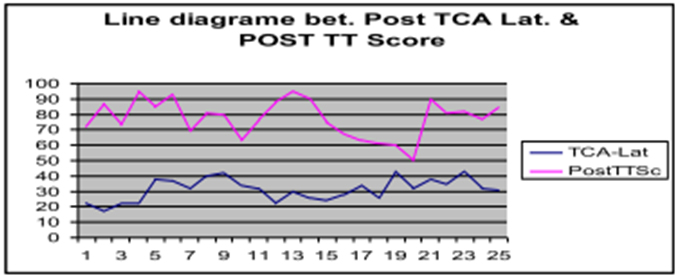
Discussion
An ideally corrected clubfoot is plantigrade, painless, pliable and cosmetically and functionally acceptable, is one which has a lasting correction which is obtained within shortest treatment time, and also does not necessitate wearing of modified shoes.
There are numerous classification systems with respect to grading of severity of clubfoot and all these different severities will give different results with a standard procedure [1,3,7].
The orthopaedic literature is scanty on an objective and easily reproducible method to assess the severity of clubfoot deformity. It is important to be able to describe the treatment and probable outcome to the parents of a baby born with clubfoot. The condition is variable in its clinical course and severity. It may be difficult to assess the severity at presentation or to compare the results of treatment.
Ponseti reported the results of treatment of clubfoot [10]. Their assessment system was based on ankle dorsiflexion, heel varus, forefoot supination and tibial torsion and the feet were graded as either good or acceptable or poor.
Pirani’s and Dimeglio’s classification systems are also more recently used and detailed scoring systems to assess the deformity and outcome evaluation [6,7]. The ideal grading system on a severity scale should: 1) involve easily reproducible objective measurements; 2) easy to learn and apply; 3) be applicable to all forms of clubfoot; 4) not be related to the age of the patient; 5) Should predict appropriate treatment at an early stage; 6) be recoverable from a retrospective record review.
Tselentakis and Paton investigated the usefulness of measuring equinus angle by correlating pre-operative angles and post-operative outcomes [11]. They used three standardized post-operative scoring systems (Magone, Turco and McKay) and demonstrated a highly significant correlation. With a minimum 2 year follow up, patients with pre-operative equinus angles less than 20 degrees had the highest rate of good/excellent result compared with those with angles greater than 40 degrees. All systems demonstrated the same findings.
Standard radiographs are commonly a part of evaluation of clubfoot; however, the utility of these techniques are historically questionable and it has been observed that, in patients with satisfactory final results, the radiographs may still show abnormal changes [4,8]. Joseph et al., studied different radiographic techniques and suggested that the difference between lateral talocalcaneal angle in dorsiflexion and plantarflexion is the best indicator of hindfoot alignment and postoperative success [4]. Residual midfoot deformity as assessed through the talar-first metatarsal angle on the lateral radiographs has also been shown to correlate with need for revision surgery when under corrected [4,5]. Further studies are warranted to predict easily reproducible radiographic techniques.
Kamegaya et al., used Magnetic Resonance Imaging (MRI) technique to assess deformity in infants and opined that MRI may be a useful tool for deformity assessment and predicting outcome [12].
Jain et al., looked at the anteromedial FBM angle and concluded that FBM angle is a good representative of the severity of deformity and used it to classify clubfoot pretreatment (whether surgical or conservative) and post-treatment with good correlation towards successful outcome [2].
We believe that, the pathology of clubfoot lies in the calcaneal rotation beneath the talus. Podography or measurement of the FBM angle attempts to quantify the deformity of clubfoot depending on an objective assessment of calcaneal rotation. The FBM angle depends on the shape of heel and the position of forefoot. The improvement in the shape of heel is a measure of correction of calcaneal rotation. The foot tracings and podography or the FBM angle may be a simple, objective, cost-effective and reproducible clinical criterion to assess and evaluate the clubfoot deformity.
There is no study in the literature which compares radiography with podography with respect to initial assessment of deformity, type of treatment protocol followed and its correlation with functional outcome with a single standardized post-treatment scoring system.
On measuring the FBM angle, no patient was falling in the normal range in our study. Only 1 out of 31 feet of Jain et al., was having a normal FBM angle [2]. Post-treatment evaluation showed improvement in all studies. In our study nearly 89% feet showed normal FBM angle following treatment. Ponseti technique of casting with carefully planned tendo achilles tenotomy has become standard of care worldwide for nearly all types of idiopathic clubfoot whether treating fresh, neglected and relapsed cases as well in children beyond 7 years of age [7,13,14]. Our study also propagates that, Ponseti technique is a highly effective way of treating idiopathic clubfoot cases.
After careful analysis of all the data we found no definite correlation between different radiological angle and functional outcome particularly talocalcaneal angle in AP view. Other radiological angles although showed improvement after treatment, still lacked any definite or proportional improvement in the functional and clinical outcome. The standard radiography is not without inter and intra-observational pitfalls. In contrast we found podographic measurement or FBM angle, though less described in literature is a very promising criterion for the assessment of deformity correction and show good correlation with functional outcome both in operative and conservative groups of patients. It is also cost effective and radiation free which is conveniently reproducible without requiring any complicated infrastructure.
Limitation
Our study does not evaluate the functional results after surgical treatment; the incidence of surgical treatment remains high due to late presentation in our population. A longer follow up with better statistical analysis is needed for podography to be established as a reliable criterion for clubfoot patients worldwide.
Conclusion
Our study proves that radiological criteria, though used commonly show inconsistent correlation with functional outcome for feet treated by Ponseti’s Technique. We have found that podography (FBM angle analysis) is a very simple, objective, cost effective, radiation free, easily reproducible and highly reliable clinical criterion for the assessment of clubfoot deformity correction by Ponseti’s Technique with an excellent correlation with functional outcome. It has also been noted that podography also helps in understanding the pathoanatomy of clubfeet and mechanism of clubfeet correction by Ponseti’s Technique.
(TC: Talo Calcaneal angle, TMT: Talo first metatarsal angle, TT: Tibio-Talar angle)